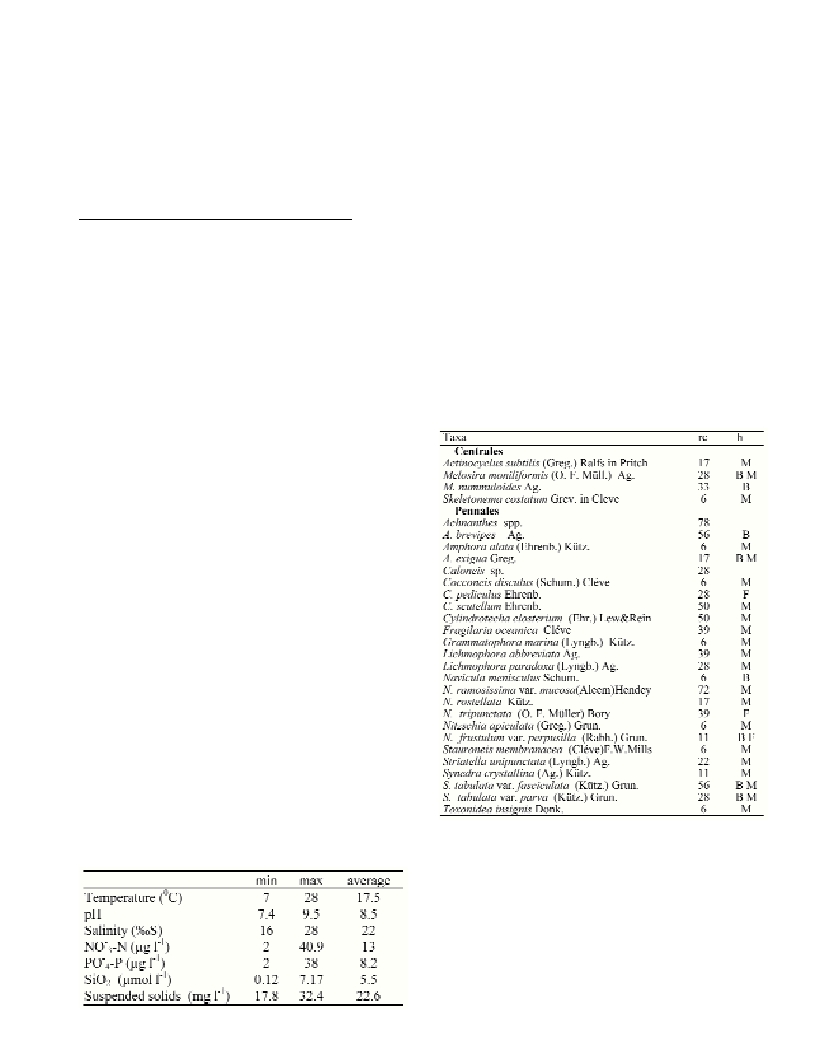EPIPHYTIC DIATOM COMMUNITY ON MACROPHITE LEAVES IN IZMIT BAY (MARMARA SEA)
Yelda Aktan
Istanbul University, Fisheries Faculty, Laleli, Istanbul, Turkey - yaktan@istanbul.edu.tr
Summary
In marine coastal ecosystems, benthic algae are important contributors to primary production and a limiting resource for sessile plants and
animals. The aim of this study, from March 1999 to September 2000, was to characterize the diatom ?ora among the algal epiphytes in
two macrophytes from Izmit Bay, Marmara Sea: Cymodocea nodosa (Ucria) AreschandZostera noltiiHorneman. Diatoms were identified
by Scanning Electron Microscopy and quantitative analyses were conducted to estimate the diatom abundance. In the study period, 4
centric, 25 pennate diatom taxa were recorded on two macrophytes.
Key words: epiphytic diatom, Izmit Bay, Marmara Sea
Rapp. Comm. int. Mer Médit., 37,2004
470
Introduction
Algal epiphytes on macro algae play an important role in marine
communities, contributing to the primary productivity of ecosystems,
supplying a main food source for animals such as molluscs and
amphipod crustaceans and comprise a major portion of the biota
present in a given area [1, 2]. As for the micro ?ora, diatoms are
always dominant. Despite the importance of benthic algae
(particularly diatoms) in marine communities, little information is
available about the timing and patterns of epiphyte distribution on
marine macrophytes [3].
This study is part of a larger investigation on the ecological
distribution of benthic diatom communities along the coast of Izmit
Bay. The aims of this study are to characterize the epiphytic diatom
?ora among the benthic algal composition and at the same time to
contribute to the knowledge of benthic diatom diversity of the
Marmara Seas.
Izmit Bay is located on the north-eastern part of Marmara Sea and
it is one of the most polluted areas in Turkey. The Bay has been
receiving more than 300 industrieseffluents, together with the
untreated domestic waste-waters from the small cities and also from
Izmit, the most populated city of the region. The Bay was also
affected by a powerful earthquake (on August 1999) and by the
subsequent fire in the refinery situated on the north-eastern coast [4].
Materials and Methods
Temperature, dissolved oxygen, salinity and pH were measured in
surface water. Nutrient (Nitrate, o-phosphate and silicate) analysis
were determined bimonthly in TÜBITAK Research Center by a
Technicon Autoanalizer II System.
Sampling was carried out monthly by SCUBA-diving and
snorkelling. A part of host plants (Cymodocea nodosaand Zostera
noltii) was fixed in 4% formaldehyde and the other parts were
desiccated to constitute a herbarium. In the laboratory, epiphytic
diatoms on host plants were separated by washing-tearing methods
and temporary slides were prepared for counting. In every counting,
minimum 100 diatoms frustules were counted and abundances were
calculated. Diatoms were identified by light and scanning electron
microscopy and photographed.
Results and Discussion
Temperature changed according to sites and seasons related also to
turbulence of wind and wave. Salinity values were considerably
varied in the littoral zone. Besides marine diatoms, freshwater species
were recorded also on epiphytic ?ora.
Macrophytes were recorded as rarely present (6%, n=18) at
Yalova and constantly present (83%, n=18) at Dereköy, a partly
sheltered area. A total of 29 epiphytic diatom taxa were recorded.
Achnanthes spp., Cocconeisspp. (true epiphytes, with adnate cells)
and Navicula ramosissimavar. mucosa(metaphyton, with motile cells
living in mucilage tubes) were dominant in these assemblages.
Cymodocea nodosaand Zostera noltiiwere suitable host plants at
selected sites because of wide distribution. Moreover, their leaves
constituted a suitable settlement surface for a characteristic micro
algal community.
Epiphytic diatoms did not show considerable seasonal variations at
Izmit Bay. However, their abundances changed. In spring and autumn,
an extensive epiphytic diatom growth was observed on the host plants
that, furthermore, besides being affected by a remarkable diatom
cover, are also colonised by small filamentous algae (Ectocarpus,
Callithamnion, Polysiphonia, Cladophoraand Ceramium).
Acknowledgments.This study was supported by the Research
Fund of Istanbul University, Project Number: T-670/190299
References
1-Scipione and Mazzella, 1992. Epiphytic diatoms in the diet of crus-
tacean amphipods of Posidonia oceanicaleaf stratum. Oebalia, XVII:
409-412.
2-Snoeijs, P., 1994. Distribution of epiphytic diatom species composi-
tion, diversity and biomass on different macroalgal hosts along seasonal
and salinity gradients in the Baltic Sea. Diatom Research, 9(1): 189-211.
3-Dural, B, Aysel, V., Lök, A, Güner, H., 1997. Benthic algal ?ora of the
natural artificial substrata of Hekim Island (Izmir, Turkey). Algological
Studies, 85, 31-48.
4-Okay, O. S., Tolun, L., Telli-Karakoç, F., Tüfekçi, H., Morkoç, E. 2001.
Izmit Bay (Turkey) ecosystem after Marmara Earthquake and subsequent
refinery fire: the long term data. Marine pollution Bulletin, 42(5):
361-369.
Table 2. Epiphytic diatom taxa, h: habitats (B=Brackish; M=Marine;
F=Freshwater) and rc: relative abundances (n=18).
Table 1. Values of physical and chemical parameters.

